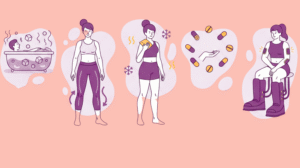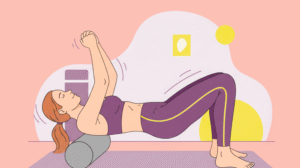Driving, whether for daily commutes or long-distance travel, often results in discomfort, particularly in the lower back, hips, and legs. Most car seats are not designed with ergonomic principles in mind, which leads to poor posture, uneven pressure distribution, and chronic pain over time. Drivers who spend extended hours behind the wheel are particularly susceptible to musculoskeletal issues.
Memory foam car seat cushions are designed to tackle these problems by providing targeted support and comfort. Made from viscoelastic foam, these cushions conform to the body’s contours, reducing pressure on sensitive areas like the lower back and tailbone while promoting proper spinal alignment. Beyond pain relief, they improve circulation, prevent stiffness, and enhance overall driving comfort.
This article will explore the science behind memory foam cushions, their various types, benefits, proper usage, maintenance tips, and how to choose the right cushion to ensure maximum comfort and long-term health benefits.
Understanding Discomfort and Posture Issues in Driving
Common Causes of Driving Pain
Extended sitting causes uneven pressure distribution across the spine, hips, and thighs. Traditional car seats often lack sufficient lumbar support, forcing the lower back into unnatural curves. Continuous exposure to vehicle vibrations, limited leg movement, and prolonged tension in the gluteal muscles further exacerbate discomfort.
Health Impacts of Poor Seating Posture
Chronic poor posture can lead to back stiffness, sciatica, tailbone pain, and numbness in the legs due to restricted circulation. With time, prolonged discomfort affects alertness, focus, and even driving performance, making pain management a crucial consideration for professional drivers and frequent commuters.
Daily Lifestyle and Driving Habits
Commuters and professional drivers are particularly vulnerable due to long durations of static sitting. Combining long drives with poor seating habits, stress, and lack of movement increases the risk of musculoskeletal pain, fatigue, and spinal misalignment.
What Is a Memory Foam Car Seat Cushion?

Definition and Function
A memory foam car seat cushion is made of high-density, viscoelastic foam that molds to the shape of the body. It responds to body heat and pressure, providing personalized comfort and support. By redistributing weight evenly, these cushions relieve pressure points on the lower back, hips, and tailbone.
Types of Memory Foam Car Seat Cushions
- Coccyx Cut-Out Cushions: These cushions feature a U-shaped cut-out at the rear to relieve pressure on the tailbone. Ideal for individuals with sciatica or chronic coccyx pain, they help reduce discomfort during long drives.
- Lumbar Support Cushions: Designed to support the lower spine, these cushions maintain the natural curvature of the back. They reduce slouching and prevent lower back strain, especially during extended periods of sitting.
- Wedge Cushions: Shaped to tilt the pelvis slightly forward, wedge cushions promote proper hip alignment. This encourages better posture and can alleviate pressure on the lower back and thighs.
- Gel-Infused Cushions: These cushions combine memory foam with cooling gel layers to regulate temperature. They enhance comfort during hot weather or long drives by reducing heat buildup and sweat.
- Full Seat + Back Combo Cushions: Offering comprehensive support, these cushions cover both the seat and back areas. They evenly distribute body weight, improve overall posture, and increase comfort for extended driving sessions.
How Memory Foam Cushions Work
Memory foam cushions conform to the individual’s body shape, distributing weight evenly across contact points. This reduces compression on the spine, tailbone, and hips while maintaining natural alignment. The foam absorbs and redistributes vibrations from the car, preventing strain on muscles and joints, especially during long drives.
Key Benefits of Memory Foam Car Seat Cushions
1. Back Pain and Pressure Relief
By conforming to body contours, memory foam cushions relieve strain on the lower back, hips, and thighs. Coccyx cut-outs or ergonomic contours reduce tailbone pressure, preventing pain during extended sitting.
2. Improved Posture Alignment
Memory foam cushions encourage proper spinal alignment and upright posture. They reduce slouching and forward-leaning tendencies, keeping the spine naturally curved and preventing long-term musculoskeletal issues.
3. Enhanced Circulation and Comfort
The foam cushions improve blood flow to the legs and lower body by reducing compression points. Better circulation prevents numbness, stiffness, and fatigue, enhancing comfort during long drives.
4. Versatility and Portability
Memory foam cushions are lightweight and portable, making them suitable for use in cars, office chairs, airplanes, or wheelchairs. Many come with straps or non-slip bases for secure placement.
5. Temperature Regulation and Breathability
Gel-infused layers and breathable covers prevent heat buildup, keeping the seating surface cool and comfortable. This is particularly beneficial for long drives in hot weather.
How to Use and Maintain a Memory Foam Cushion
Using a memory foam cushion correctly can significantly improve comfort and prevent long-term spinal or tailbone issues. Proper use and maintenance ensure the cushion delivers maximum benefits and lasts longer.
Proper Placement
The effectiveness of a memory foam cushion depends heavily on how it is positioned:
- Lumbar Support: If the cushion is designed for the lower back, place it in the small of your back, aligning with the natural curve of your spine. Ensure it fits snugly without pushing you forward.
- Coccyx Support: For tailbone cushions, position the cut-out section or tapered end at the rear to relieve pressure on the coccyx. The cushion should evenly distribute your body weight across the hips and thighs.
- Seat Integration: The cushion should sit flat on the car seat without folding or sliding. Many cushions come with straps or non-slip bottoms to prevent movement while driving.
Gradual Use
Memory foam requires a short adaptation period:
- Start with 15–30 minutes per session, gradually increasing to longer durations as your body adjusts.
- Sudden prolonged use may cause temporary discomfort or muscle soreness as your body adapts to proper spinal alignment.
- Track how your back and hips feel after each drive; adjust placement if you experience pressure points.
Maintain Good Posture
A cushion works best when paired with ergonomic seating habits:
- Adjust the seat height so your knees are level with your hips or slightly lower.
- Set the backrest angle to roughly 100–110 degrees for optimal lumbar support.
- Keep shoulders relaxed, and avoid slouching even with a cushion, as long periods of poor posture can negate the cushion’s benefits.
Cleaning and Care
Proper cleaning preserves hygiene and cushion integrity:
- Removable covers: Wash them according to manufacturer instructions, usually in cold water on gentle cycles, and air-dry to prevent shrinkage.
- Memory foam care: Avoid direct sunlight, high heat, or excessive moisture, which can degrade foam density and resilience. Do not machine-wash the foam itself.
- Odor management: Air out new cushions for 24–48 hours to remove the factory smell; occasional airing during regular use prevents mustiness.
Replacement
Memory foam cushions wear out over time:
- Replace when the foam loses firmness or permanent indentations form.
- A deformed cushion can reduce support, potentially worsening posture issues.
- High-quality memory foam cushions typically last 2–5 years depending on usage, weight distribution, and care.
Choosing the Right Memory Foam Cushion for Your Car
Selecting the right cushion ensures comfort, durability, and ergonomic benefit. Consider your specific needs and vehicle setup.
1. Assess Your Needs
Understanding the primary source of discomfort helps you choose an appropriate cushion:
- Tailbone pain: Look for U-shaped or cut-out cushions to relieve coccyx pressure.
- Lower back pain: Opt for cushions with firm lumbar support or wedge designs to maintain natural spinal curvature.
- General stiffness: Full-seat memory foam pads distribute weight evenly and reduce overall fatigue.
Other factors to consider:
- Body weight: Higher-density foam supports heavier users without bottoming out, while softer foam may suit lighter individuals.
- Seating position: Cushions designed for bucket seats may differ from flat or bench-style seats.
- Driving duration: Long drives benefit from thicker, more supportive foam, while short commutes may require a lighter, portable cushion.
2. Key Buying Features
When shopping for memory foam cushions, pay attention to:
- Density and firmness: Medium-to-high-density foam balances comfort and support; too-soft foam may sag, while very firm foam can feel uncomfortable.
- Non-slip base: Prevents sliding, ensuring consistent support while braking or turning.
- Breathable, washable covers: Keeps you cool, reduces sweat accumulation, and makes cleaning simple.
- Temperature control: Gel-infused or ventilated designs can prevent heat retention during summer.
- Portability and weight: Lightweight cushions are easier to move between vehicles or use outside the car.
3. Professional Advice and Compatibility
For those with chronic pain or orthopedic concerns:
- Consult a physiotherapist or orthopedic specialist before choosing a cushion. They can recommend specific shapes, densities, or positions to support your spinal health.
- Vehicle fit: Measure your car seat and check the cushion dimensions to ensure snug fit. An ill-fitting cushion can slide or fail to provide adequate support.
- Posture alignment: Choose a cushion that complements seat adjustments, allowing a natural and relaxed driving posture
Complementary Habits for Better Driving Comfort
- Adjust car seat height and steering angle for ergonomic alignment.
- Take short breaks every 1–2 hours on long drives.
- Perform simple stretches for back, hip, and leg muscles.
- Maintain a neutral spine and relaxed shoulders while driving.
- Stay hydrated to prevent muscle stiffness.
- Incorporate core-strengthening exercises to support posture and reduce discomfort.
Conclusion
Memory foam car seat cushions are essential tools for improving comfort, reducing back and tailbone pain, and promoting proper posture during long drives. Selecting the right type and using it correctly ensures maximum benefit for daily commuters, professional drivers, and anyone who spends extended time sitting. Coupled with ergonomic driving habits and proper care, these cushions enhance overall well-being and driving experience.
If you suffer from sleep issues, make sure to check these articles:
Frequently Asked Questions
1. What is a memory foam car seat cushion, and how does it work?
Conforms to body shape, reduces pressure points, and supports spinal alignment.
2. Can memory foam cushions help relieve lower back pain while driving?
Yes, they reduce strain and promote proper posture.
3. How long does a memory foam seat cushion last?
Typically 2–5 years, depending on quality and usage.
4. Are gel-infused cushions better for hot climates?
Yes, they prevent heat buildup and keep seating cool.
5. How do I clean and maintain a memory foam car seat cushion?
Wash removable covers, air-dry foam, and avoid moisture and direct sunlight.
References
- Bandy, W. D., & Sanders, B. (2008). Therapeutic exercise for physical therapist assistants. Lippincott, Williams & Wilkins. Retrieved from https://cmc.marmot.org/Record/.b27688586
- Review on ergonomic design of a car seat. Retrieved from https://irjmets.com/uploadedfiles/paper//issue_3_march_2022/19852/final/fin_irjmets1647363225.pdf
- Ergonomics for passenger cars. Retrieved from https://www.researchgate.net/publication/277693801_Ergonomics_for_Passenger_Cars
- Therapeutic exercise text (archive) Retrieved from https://archive.org/details/therapeuticexerc0000unse



















